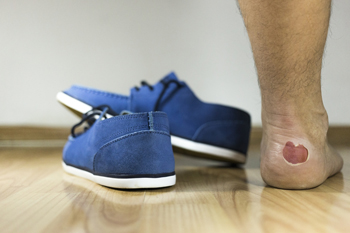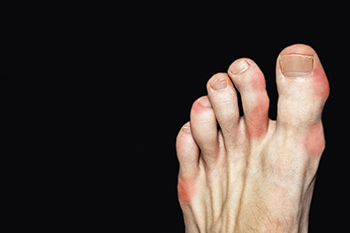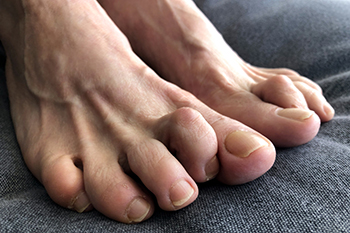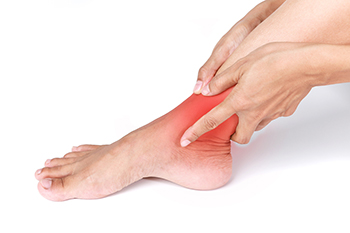

There is a medical condition that is known as dyshidrotic eczema which can produce blisters on the feet. They are generally itchy and can last several weeks. The blisters may appear on the soles of the feet or between the toes and are often uncomfortable. The first signs this ailment may be developing consist of a burning or prickly sensation on the skin of the feet. It is a long-term condition that can disappear over time and then reappear. The skin often becomes dry and using a good moisturizer may help the skin to feel better. It is beneficial to wear socks or stockings that are made from cotton or silk and to refrain from wearing any type of nylon. Additionally, it can help to wear shoes that are made from leather materials and to refrain from using harsh detergents while washing the socks. If you have a chronic condition where blisters appear on your feet, it is strongly suggested that you consult the expertise of a podiatrist who can guide you toward the correct treatment techniques.
Blisters are prone to making everyday activities extremely uncomfortable. If your feet are hurting, contact Dr. Larry Cohen of New York City. Our doctor can provide the care you need to keep you pain-free and on your feet.
Foot Blisters
Foot blisters develop as a result of constantly wearing tight or ill-fitting footwear. This happens due to the constant rubbing from the shoe, which can often lead to pain.
What Are Foot Blisters?
A foot blister is a small fluid-filled pocket that forms on the upper-most layer of the skin. Blisters are filled with clear fluid and can lead to blood drainage or pus if the area becomes infected.
How Do Blisters Form?
Blisters on the feet are often the result of constant friction of skin and material, usually by shoe rubbing. Walking in sandals, boots, or shoes that don’t fit properly for long periods of time can result in a blister. Having consistent foot moisture and humidity can easily lead to blister formation.
Prevention & Treatment
It is important to properly care for the affected area in order to prevent infection and ease the pain. Do not lance the blister and use a Band-Aid to provide pain relief. Also, be sure to keep your feet dry and wear proper fitting shoes. If you see blood or pus in a blister, seek assistance from a podiatrist.
If you have any questions, please feel free to contact our offices located in Midtown, Manhattan New York, NY . We offer the newest diagnostic and treatment technologies for all your foot care needs.

Severe pain, swelling, and redness surrounding the joint in the big toe can be indicative gout. It is a form of arthritis, and it can come from genetic factors or from eating foods that are high in purine levels. Elevated levels of purine can produce uric acid, and form crystals that can build up in the joints of the big toe. Some foods that have large amounts of purines include red meat, shellfish, and drinks that are made with large amounts of sugar. Additionally, people who are overweight, have high blood pressure, or who are diabetic may be prone to getting gout. This condition occurs in flare-ups and can last up to a week. Chronic gout may cause loss of mobility and joint damage. There are effective preventative methods that may help to control the onset of gout. These can consist of incorporating a healthy diet into your daily routine, performing simple exercise programs, and maintaining an acceptable weight. If you suffer from gout, it is strongly suggested that you are under the care of a podiatrist who can help you with additional prevention and treatment options.
Gout is a foot condition that requires certain treatment and care. If you are seeking treatment, contact Dr. Larry Cohen from New York City. Our doctor will treat your foot and ankle needs.
What Is Gout?
Gout is a type of arthritis caused by a buildup of uric acid in the bloodstream. It often develops in the foot, especially the big toe area, although it can manifest in other parts of the body as well. Gout can make walking and standing very painful and is especially common in diabetics and the obese.
People typically get gout because of a poor diet. Genetic predisposition is also a factor. The children of parents who have had gout frequently have a chance of developing it themselves.
Gout can easily be identified by redness and inflammation of the big toe and the surrounding areas of the foot. Other symptoms include extreme fatigue, joint pain, and running high fevers. Sometimes corticosteroid drugs can be prescribed to treat gout, but the best way to combat this disease is to get more exercise and eat a better diet.
If you have any questions please feel free to contact our offices located in Midtown, Manhattan New York, NY . We offer the newest diagnostic and treatment technologies for all your foot and ankle needs.

The noticeable symptom with a foot condition that is known as hammertoe affects the second toe. It is considered to be a deformity, and a muscle imbalance causing the toe to bend downward. Additionally, corns can form on top of the bone that is bent. This can be a result of the pressure that is endured as the top of the toes rub against shoes. Hammertoe can happen from genetic reasons, or possibly from wearing shoes that do not have adequate room for the toes to move freely in. Some patients have high arches, and this can contribute to developing hammertoe. If the condition is severe, surgery may be necessary in helping to permanently straighten the toes. It is considered to be an unsightly foot condition, and it may be difficult to walk. If you have a hammertoe, it is strongly advised that you are under the care of a podiatrist who can effectively treat this condition.
Hammertoe
Hammertoes can be a painful condition to live with. For more information, contact Dr. Larry Cohen from New York City. Our doctor will answer any of your foot- and ankle-related questions.
Hammertoe is a foot deformity that affects the joints of the second, third, fourth, or fifth toes of your feet. It is a painful foot condition in which these toes curl and arch up, which can often lead to pain when wearing footwear.
Symptoms
Causes
Genetics – People who are genetically predisposed to hammertoe are often more susceptible
Arthritis – Because arthritis affects the joints in your toes, further deformities stemming from arthritis can occur
Trauma – Direct trauma to the toes could potentially lead to hammertoe
Ill-fitting shoes – Undue pressure on the front of the toes from ill-fitting shoes can potentially lead to the development of hammertoe
Treatment
Orthotics – Custom made inserts can be used to help relieve pressure placed on the toes and therefore relieve some of the pain associated with it
Medications – Oral medications such as anti-inflammatories or NSAIDs could be used to treat the pain and inflammation hammertoes causes. Injections of corticosteroids are also sometimes used
Surgery – In more severe cases where the hammertoes have become more rigid, foot surgery is a potential option
If you have any questions please contact our offices located in Midtown, Manhattan New York, NY . We offer the newest diagnostic and treatment technologies for all your foot and ankle needs.

A type of injury that affects the lower inside of the leg, ankle, and arch is known as posterior tibialis tendonitis. Because injury to this tendon can easily be overlooked, it may cause ongoing problems with stability and arch support. Further, it can cause flat feet. Symptoms include painful inflammation to the inside of the ankle, difficulty bearing weight, tightness when flexing the foot, and tenderness in the arch. The most common causes of posterior tibialis tendonitis are a change in gait to compensate for pain from another injury or swelling in the ankle joint. One way to detect posterior tibialis tendonitis is to stand on tiptoe on the affected leg. Pain in this position may indicate injury. If so, it is a good idea to consult a podiatrist for a thorough exam and treatment options.
Ankle pain can be caused by a number of problems and may be potentially serious. If you have ankle pain, consult with Dr. Larry Cohen from New York City. Our doctor will assess your condition and provide you with quality foot and ankle treatment.
Ankle pain is any condition that causes pain in the ankle. Due to the fact that the ankle consists of tendons, muscles, bones, and ligaments, ankle pain can come from a number of different conditions.
Causes
The most common causes of ankle pain include:
Symptoms
Symptoms of ankle injury vary based upon the condition. Pain may include general pain and discomfort, swelling, aching, redness, bruising, burning or stabbing sensations, and/or loss of sensation.
Diagnosis
Due to the wide variety of potential causes of ankle pain, podiatrists will utilize a number of different methods to properly diagnose ankle pain. This can include asking for personal and family medical histories and of any recent injuries. Further diagnosis may include sensation tests, a physical examination, and potentially x-rays or other imaging tests.
Treatment
Just as the range of causes varies widely, so do treatments. Some more common treatments are rest, ice packs, keeping pressure off the foot, orthotics and braces, medication for inflammation and pain, and surgery.
If you have any questions, please feel free to contact our offices located in Midtown, Manhattan New York, NY . We offer the newest diagnostic and treatment technologies for all your foot care needs.